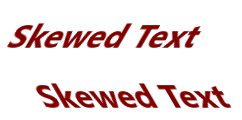SkewTransform Class
Definition
Important
Some information relates to prerelease product that may be substantially modified before it’s released. Microsoft makes no warranties, express or implied, with respect to the information provided here.
Represents a two-dimensional skew.
public ref class SkewTransform sealed : Transform/// [Windows.Foundation.Metadata.Activatable(65536, "Microsoft.UI.Xaml.WinUIContract")]
/// [Windows.Foundation.Metadata.ContractVersion(Microsoft.UI.Xaml.WinUIContract, 65536)]
/// [Windows.Foundation.Metadata.MarshalingBehavior(Windows.Foundation.Metadata.MarshalingType.Agile)]
/// [Windows.Foundation.Metadata.Threading(Windows.Foundation.Metadata.ThreadingModel.Both)]
class SkewTransform final : Transform[Windows.Foundation.Metadata.Activatable(65536, "Microsoft.UI.Xaml.WinUIContract")]
[Windows.Foundation.Metadata.ContractVersion(typeof(Microsoft.UI.Xaml.WinUIContract), 65536)]
[Windows.Foundation.Metadata.MarshalingBehavior(Windows.Foundation.Metadata.MarshalingType.Agile)]
[Windows.Foundation.Metadata.Threading(Windows.Foundation.Metadata.ThreadingModel.Both)]
public sealed class SkewTransform : TransformPublic NotInheritable Class SkewTransform
Inherits Transform<SkewTransform .../>
- Inheritance
- Attributes
Examples
This example uses a SkewTransform to skew text. A skew, also known as a shear, is a transformation that stretches the coordinate space in a non-uniform manner. In this example, the two text strings are skewed -30 degrees and 30 degrees along the x-coordinate.
<Canvas Margin="30">
<!-- Skew the text using a SkewTransform. -->
<TextBlock FontSize="32"
FontWeight="Bold"
Foreground="Maroon"
Text="Skewed Text">
<TextBlock.RenderTransform>
<SkewTransform AngleX="-30" AngleY="0" />
</TextBlock.RenderTransform>
</TextBlock>
<TextBlock Canvas.Top="60"
FontSize="32"
FontWeight="Bold"
Foreground="Maroon"
Text="Skewed Text">
<TextBlock.RenderTransform>
<SkewTransform AngleX="30" AngleY="0" />
</TextBlock.RenderTransform>
</TextBlock>
</Canvas>
The text looks like this after the transform is applied:

This example shows how you can access and modify a transform in code at runtime. Each time the rectangle is pressed, the skew is increased.
<Rectangle PointerPressed="IncreaseSkew"
Width="50" Height="50"
Fill="RoyalBlue">
<Rectangle.RenderTransform>
<!-- If you give the transform a name
you can access it easily from code. -->
<SkewTransform x:Name="mySkewTransform" />
</Rectangle.RenderTransform>
</Rectangle>
public void IncreaseSkew(object sender, RoutedEventArgs e)
{
mySkewTransform.AngleX = mySkewTransform.AngleX + 5;
}
Constructors
| SkewTransform() |
Initializes a new instance of the SkewTransform class. |
Properties
| AngleX |
Gets or sets the x-axis skew angle, which is measured in degrees counterclockwise from the y-axis. |
| AngleXProperty |
Identifies the AngleX dependency property. |
| AngleY |
Gets or sets the y-axis skew angle, which is measured in degrees counterclockwise from the x-axis. |
| AngleYProperty |
Identifies the AngleY dependency property. |
| CenterX |
Gets or sets the x-coordinate of the transform center. |
| CenterXProperty |
Identifies the CenterX dependency property. |
| CenterY |
Gets or sets the y-coordinate of the transform center. |
| CenterYProperty |
Identifies the CenterY dependency property. |
| Dispatcher |
Always returns |
| DispatcherQueue |
Gets the |
| Inverse |
Gets the inverse transformation of this GeneralTransform, if possible. (Inherited from GeneralTransform) |
| InverseCore |
Implements the behavior for return value of Inverse in a derived or custom GeneralTransform. (Inherited from GeneralTransform) |
Methods
| ClearValue(DependencyProperty) |
Clears the local value of a dependency property. (Inherited from DependencyObject) |
| GetAnimationBaseValue(DependencyProperty) |
Returns any base value established for a dependency property, which would apply in cases where an animation is not active. (Inherited from DependencyObject) |
| GetValue(DependencyProperty) |
Returns the current effective value of a dependency property from a DependencyObject. (Inherited from DependencyObject) |
| ReadLocalValue(DependencyProperty) |
Returns the local value of a dependency property, if a local value is set. (Inherited from DependencyObject) |
| RegisterPropertyChangedCallback(DependencyProperty, DependencyPropertyChangedCallback) |
Registers a notification function for listening to changes to a specific DependencyProperty on this DependencyObject instance. (Inherited from DependencyObject) |
| SetValue(DependencyProperty, Object) |
Sets the local value of a dependency property on a DependencyObject. (Inherited from DependencyObject) |
| TransformBounds(Rect) |
Transforms the specified bounding box and returns an axis-aligned bounding box that is exactly large enough to contain it. (Inherited from GeneralTransform) |
| TransformBoundsCore(Rect) |
Provides the means to override the TransformBounds behavior in a derived transform class. (Inherited from GeneralTransform) |
| TransformPoint(Point) |
Uses this transformation object's logic to transform the specified point, and returns the result. (Inherited from GeneralTransform) |
| TryTransform(Point, Point) |
Attempts to transform the specified point and returns a value that indicates whether the transformation was successful. (Inherited from GeneralTransform) |
| TryTransformCore(Point, Point) |
Provides the means to override the TryTransform behavior in a derived transform class. (Inherited from GeneralTransform) |
| UnregisterPropertyChangedCallback(DependencyProperty, Int64) |
Cancels a change notification that was previously registered by calling RegisterPropertyChangedCallback. (Inherited from DependencyObject) |